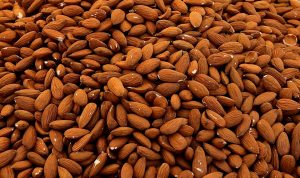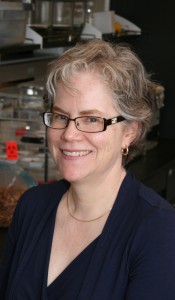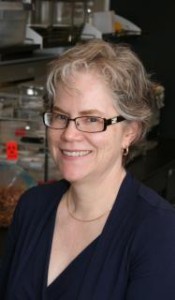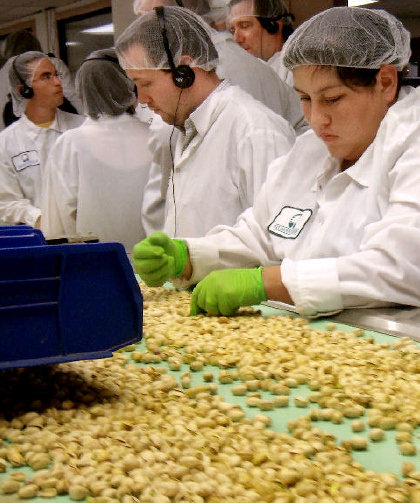New International Association for Food Protection president, committee member for my PhD and all-round nice person (who won’t be put in the corner), Linda Harris, leads a new paper reviewing the safety of in-shell pistachios.
 After harvest, pistachios are hulled with mechanical abrasion and then separated in a float tank containing water; the nuts that float (∼15%; floaters) and those that sink (∼85%; sinkers) are dried and stored separately. To determine the prevalence of Salmonella in pistachios, a total of 3,966 samples (1,032 floaters and 2,934 sinkers) were collected within 4 months of the 2010, 2011, and 2012 harvests from storage silos (12 samples from each silo, in most cases) and were stored at 4°C; 100-g subsamples were enriched for the presence of Salmonella.
After harvest, pistachios are hulled with mechanical abrasion and then separated in a float tank containing water; the nuts that float (∼15%; floaters) and those that sink (∼85%; sinkers) are dried and stored separately. To determine the prevalence of Salmonella in pistachios, a total of 3,966 samples (1,032 floaters and 2,934 sinkers) were collected within 4 months of the 2010, 2011, and 2012 harvests from storage silos (12 samples from each silo, in most cases) and were stored at 4°C; 100-g subsamples were enriched for the presence of Salmonella.
Twenty-one of the floater samples and 11 of the sinker samples were positive forSalmonella: 2.0% prevalence (95% confidence interval [CI], 1.3 to 3.1%) and 0.37% prevalence (95% CI, 0.21 to 0.67%), respectively, for a weighted average prevalence of 0.61%. Levels of Salmonella were determined for positive samples using a most-probable-number (MPN) method with multiple 50-g, three 5.6-g, and three 0.56-g subsamples. Geometric mean levels of Salmonella in floaters and sinkers were 0.66 MPN/100 g (0.14 to 5.3 MPN/100 g) and 0.18 MPN/100 g (0.10 to 0.62 MPN/100 g), respectively. Seven different serovars were identified among the isolates, with nine pulsed-field gel electrophoresis fingerprints; as many as four serovars were isolated from some samples. Salmonella serovars Montevideo (44%), Enteritidis (19%), Senftenberg (16%), Worthington (12%), and Liverpool (9.4%) were most commonly isolated from the initial 100-g samples.
The prevalence and levels of Salmonella in pistachios are within those observed for other tree nuts, but the limited number of serovars isolated suggests a narrow and persistent contamination source.
Prevalence and amounts of Salmonella found on raw California inshell pistachios
Harris, Linda J.1; Lieberman, Vanessa2; Mashiana, Rupinder P.2; Atwill, Edward3; Yang, Mai4; Chandler, Jeffrey C.5; Bisha, Bledar6; Jones, Thomas4
1: Department of Food Science and Technology, Western Center for Food Safety, University of California, Davis, One Shields Avenue, Davis, California 95616, USA;, Email: ljharris@ucdavis.edu 2: Department of Food Science and Technology, University of California, Davis, One Shields Avenue, Davis, California 95616, USA 3: Western Center for Food Safety, Department of Population, Health, and Reproductive Medicine, University of California, Davis, One Shields Avenue, Davis, California 95616, USA 4: DFA of California, 1855 South Van Ness Avenue, Fresno, California 93721, USA 5: Department of Animal Science, University of Wyoming, 1000 East University Avenue, Laramie, Wyoming 82071, USA, Department of Agriculture, National Wildlife Research Center, 4101 LaPorte Avenue, Fort Collins, CO 80521, USA 6:Department of Animal Science, University of Wyoming, 1000 East University Avenue, Laramie, Wyoming 82071, USA
Journal of Food Protection, August 2016, Number 8, Pages 1304-1315, DOI: http://dx.doi.org/10.4315/0362-028X.JFP-16-054
http://www.ingentaconnect.com/content/iafp/jfp/2016/00000079/00000008/art00001






 This time it’s pistachios. On March 30,
This time it’s pistachios. On March 30,  David Acheson, FDA associate commissioner, said,
David Acheson, FDA associate commissioner, said,